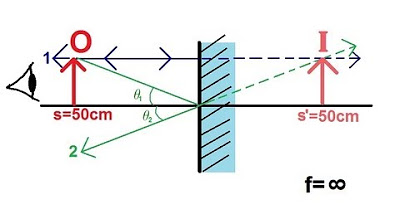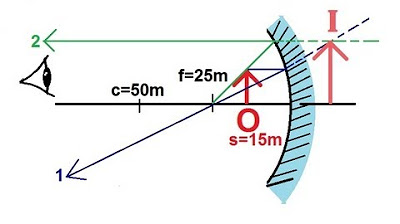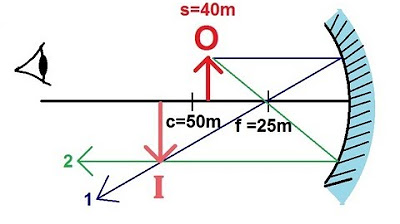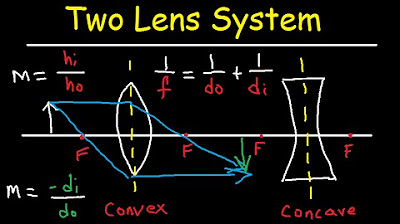Physics 54 Optics: Mirrors (4 of 6) Convex Mirror
TLDRThis educational video script explains the concept of a convex mirror, characterized by its outward bulging surface and negative focal length. The script guides viewers through the process of determining the location and nature of the image formed by a convex mirror, using the example of an object placed 100 cm away. It demonstrates how rays reflect from the mirror to form a virtual, upright, and diminished image, with a magnification of 1/5th the size of the object. The explanation clarifies the principles of reflection and the mathematical approach to calculate image distance and magnification, providing a clear understanding of convex mirrors.
Takeaways
- 🔍 Convex mirrors bulge outwards, not towards the observer, and have a negative focal length, indicating the focal point is behind the mirror.
- 👁️ The observer's eye is used to represent the viewer looking at the convex mirror.
- 📏 The focal length for convex mirrors is negative, and it's important to include this negative sign when calculating image properties.
- 🔄 Convex mirrors create virtual images, meaning the image appears to be behind the mirror and cannot be projected onto a screen.
- 🌐 The center of curvature for a convex mirror is also behind the mirror, which is a key characteristic of its shape.
- 📐 The script describes a method to draw and analyze the path of light rays reflecting off a convex mirror to determine image properties.
- 🏷️ Ray number one is drawn parallel to the normal and reflects as if it came from the focal point, which helps in determining the image location.
- 🏷️ Ray number two is drawn from the object to the focal point, reflecting back parallel to the normal, indicating no convergence to form a real image.
- 📈 The image distance (S') can be calculated using the formula S' = -F / (S - F), where S is the object distance and F is the focal length.
- 🔢 A specific example in the script calculates the image distance to be 20 cm behind the mirror for an object placed 100 cm away with a focal length of -25 cm.
- 🔄 The magnification (m) of the image is found using the formula m = -S' / S, resulting in a positive value indicating an upright image that is smaller than the object.
Q & A
What is a convex mirror?
-A convex mirror is a type of mirror that bulges outward, away from the observer, and has a negative focal length, meaning its focal point and center of curvature are behind the mirror.
Why is it important to remember the negative sign when dealing with convex mirrors?
-The negative sign in front of the focal length for convex mirrors indicates that the focal point is behind the mirror, which is crucial for understanding how the mirror will form images.
What happens when an object is placed 100 cm in front of a convex mirror?
-The image formed by a convex mirror when an object is placed 100 cm away will be virtual, meaning it appears to be behind the mirror, and will be smaller and upright compared to the object.
How are the rays traced in the script to determine the image formation by a convex mirror?
-Two rays are traced from the object: one parallel to the principal axis that reflects as if it came from the focal point, and the other from the object through the focal point that reflects parallel to the principal axis after hitting the mirror.
Why do the reflected rays not converge to form a real image?
-The reflected rays from a convex mirror do not converge because they diverge after reflection, which means they cannot form a real image on a screen but instead form a virtual image by the observer's brain interpolating the rays.
What is the formula used to calculate the image distance (S') in the script?
-The formula used to calculate the image distance (S') is S' = -F / (S - F), where S is the object distance, and F is the focal length of the mirror.
What was the calculated image distance for the object placed 100 cm away from the mirror with a focal length of -25 cm?
-The calculated image distance for the given scenario is -20 cm, which indicates that the image is 20 cm behind the mirror.
What does the negative value of the image distance signify?
-A negative value of the image distance signifies that the image is virtual and located behind the mirror, as opposed to a real image which would be in front of the mirror.
How is the magnification of the image determined, and what does its value indicate?
-The magnification (m) is determined by the formula m = -S' / S. A positive magnification value indicates that the image is upright, while the ratio indicates the size of the image relative to the object.
What is the magnification of the image in the given example, and what does this mean about the image orientation?
-The magnification of the image in the example is 1/5, which means the image is one-fifth the size of the object and is upright, assuming the object was initially in a standard orientation.
What is the caveat mentioned in the script regarding the interpretation of the magnification sign?
-The caveat is that if the object is upside down, a positive magnification would result in an upside-down image. The positive sign simply indicates that the image is in the same orientation as the object, assuming the object starts in a positive orientation.
Outlines
🔍 Understanding Convex Mirrors and Their Properties
This paragraph introduces the concept of a convex mirror, which is characterized by its outward bulging surface that faces the observer. The focal point of a convex mirror is behind the mirror, resulting in a negative focal length. The paragraph explains the process of image formation by convex mirrors, including the reflection of light rays as if they come from the focal point. It also discusses the calculation of image distance using the formula S' = SF / (s - f), where S is the object distance, F is the focal length, and s is the distance from the object to the mirror. The example given involves an object placed 100 cm away from the mirror with a focal length of -25 cm, resulting in an image formed 20 cm behind the mirror, indicating a virtual image. The paragraph concludes with the calculation of magnification, which is positive and 1/5th the size of the object, suggesting an upright image.
Mindmap
Keywords
💡Convex Mirror
💡Focal Length
💡Center of Curvature
💡Virtual Image
💡Magnification
💡Upright Image
💡Ray Tracing
💡Normal Line
💡Reflection
💡Object Distance
💡Image Distance
Highlights
Convex mirrors bulge away from the observer, causing the focal point and center of curvature to be behind the mirror.
Focal lengths for convex mirrors are negative, indicating the focal point is behind the mirror.
The first ray is drawn parallel to the normal and reflects as if coming from the focal point.
The second ray is drawn from the object to the focal point, reflecting parallel to the normal.
Convex mirrors do not form a real image as the reflected rays do not converge.
The brain extrapolates a virtual image location where the rays appear to diverge from.
The image distance (S') is calculated using the formula S' = -f(s - f) / s.
For the given example, the object is placed 100 cm away from the mirror with a focal length of -25 cm.
The calculated image distance is -20 cm, indicating a virtual image 20 cm behind the mirror.
A negative image distance confirms the image is virtual, not physically present.
Magnification (m) is calculated as the ratio of image distance to object distance, m = -S'/S.
The magnification of 1/5 indicates the image is 1/5th the size of the object.
A positive magnification value means the image is upright relative to the object.
If the object were upside down, a positive magnification would result in an upside-down image.
The direction of the image relative to the object is determined by the sign of the magnification.
Convex mirrors are useful for creating upright, smaller virtual images, which is practical for certain applications.
Transcripts
Browse More Related Video

Concave Mirrors and Convex Mirrors Ray Diagram - Equations / Formulas & Practice Problems

Physics 51/54 - Optics: Mirrors (6 of 6) Flat Mirror

Physics 54 Optics: Mirrors (3 of 6) Concave Mirror

Ray Diagrams

Physics 54 Optics: Mirrors (2 of 6) Concave Mirror

Multiple Two Lens System with Diverging and Converging Lens
5.0 / 5 (0 votes)
Thanks for rating: